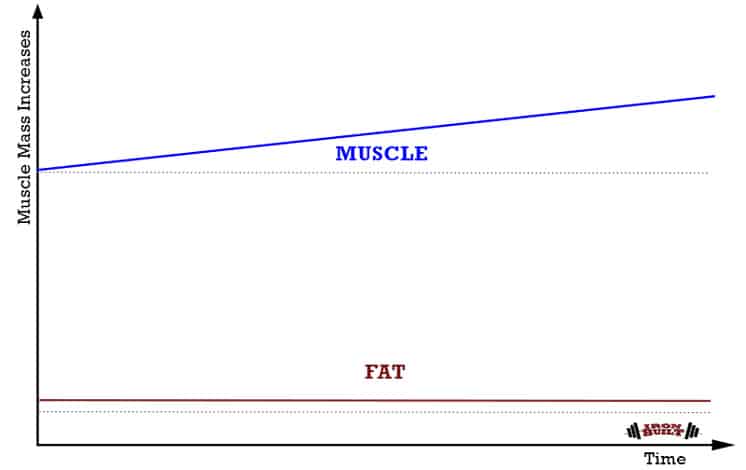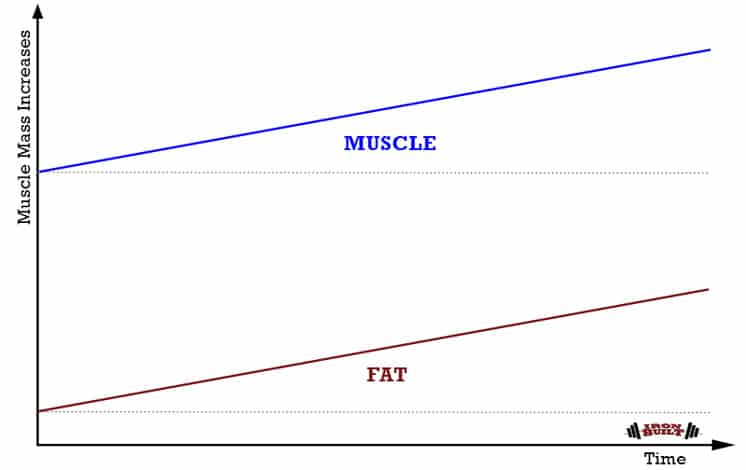
In the beginning of my fitness journey I thought that the quicker I could gain weight, the more muscle I would build. But unfortunately, it didn’t really turn out that way. In fact, most of the weight I gained was fat and not muscle.
The bottom line is that how fast you choose to gain weight dictates how much of the weight you gain on a bulk is fat or muscle. And we all want to gain as muscle and as little fat as possible, right?
So with that said, how fast should you gain weight on a bulk? In order to gain muscle without adding unnecessary fat to your physique you should gain weight in a rate accordingly to your training experience. If you want to make sure that you are maximizing muscle growth you should gain slightly faster than what your training experience dictate.
As you can see, the rate of which you should gain weight when bulking is mainly dictated by your training experience.
In this post I’ll pin down how fast you ideally should gain weight depending on your level of training experience, I’ll discuss some of the other factors determining your rate of gains, and finally I’ll do my best to provide you with some metrics that you can measure to ensure that you’re building mostly muscle and not adding fat when bulking.
Let’s go.
Table of Contents
Factors Influencing How Fast You Should Gain Weight When Bulking
Before moving on I think that it’s important to change the words weight gain to muscle gain. All of us want to gain as much lean muscle mass as possible, not body fat when bulking. The problem with using the words “weight gain” is that it can give the wrong impression that it’s okay, or ideal to gain a ton of body weight no matter what this weight is composed of.
But, the way to build a lean, muscular and aesthetic looking physique is to focus on muscle gain and not fat gain. Sure, some fat gain will be inevitable if you want to build muscle at any noticeable speed, all I’m saying is that it shouldn’t be the focus, alright?
Now, there are three main factors that can influence your rate of muscle gain, and these are:
- Training experience
- Genetics
- Lifestyle factors
Out of these three, the one that will have the most influence on your muscle gaining potential is your training experience. You can’t do anything about your genetics so there’s no point getting stuck on that. And even though changes to your lifestyle can improve muscle growth it won’t do so nearly as much as what changes in your training experience will do.
How Fast Can You Gain Muscle Depending on Your Training Experiences?
Thanks to the work done by Alan Aragon and Lyle McDonald we now have a good idea of the maximum muscle growth potential that we can expect on average.
Accordingly to Alan Aragon the maximum rate of muscle growth per year is this one:
| Category | Maximum Rate of Muscle Growth |
|---|---|
| Beginner
Intermediate Advanced |
1-1.5% of lean body mass per month
0.5-1% of lean body mass per month 0.25-0.5% of lean body mass per month |
And here’s another model by Lyle McDonald, which basically says the same thing, but in weight of lean body mass gain per month. I like this model more since it give more clear and directly tangible numbers:
| Years of Training | Maximum Muscle Growth Potential |
|---|---|
| Year 1
Year 2 Year 3 Year 4 Year 5+ |
20-25lbs (2lbs per month) / 9 – 11 kg (0.9kg per month)
10-12lbs (1lbs per month) / 4.5 – 5.5 kg (0.45kg per month) 5-6lbs (0.5lbs per month) / 2 – 2.7 kg (0.22kg per month) 2-3lbs / 0.9 – 1.3 kg 2-3 lbs / 0.9 – 1.3kg |
As you can see in these tables, a beginner trainee can grow very quickly, with rates up to 2 lbs (0.9 kg) of muscle mass per month. While an advanced trainee will see extremely slow gains in muscle mass, perhaps 2 lbs (0.9 kg) per year and even slower the more advanced he becomes.
*Quick note here: The numbers in the two tables above only holds true if you’re using a well set up training program. Your training is more important than your diet when it comes to muscle growth (more on that later).
How to Set up Your Calorie Surplus Based on Your Muscle Gaining Potential
Okay, so in order to add the amount of muscle mass to your frame accordingly to your training experience, it’s important that you’re actually gaining weight, and this is done by placing yourself in a calorie surplus. You can’t expect to gain 20-25 lbs as a beginner without being in a calorie surplus.
This is by the way the reason why bulking and cutting cycles are so effective. Now, sure you could use a body recomposition strategy where you’re slowly using body fat to fuel your muscle building process, but this reduces your gaining potential a lot.
Now, there are two ways to do a bulk:
- Set up your calorie surplus to gain muscle with minimal fat
- Set up your calorie surplus to maximize muscle growth
Let’s look at these approaches one by one and how you would set up your surplus using either approach depending on your training experience:
1. How to Set up Your Calorie Surplus to Gain Muscle With Minimal Fat
Most people agree that it takes around 2500 calories to build 1 lb of muscle, these 2500 calories must come from a surplus of food. If you choose to gain muscle with minimal fat gain your rate of muscle growth will be reduced slightly, but you won’t gain as much fat either. Here’s a good way to look at it:

You gain decent amounts of muscle with minimal fat gain.
Side note: For individuals that are very overweight, a surplus of calories coming in from food is not required to build muscle. An overweight individual already have excess of calories stored as body fat, which provides the muscle building process with sufficient energy to maximize muscle growth. Until they get down to a lower body fat percentage.
But if you’re not overweight, which would be around 20-25 % bf for males, then this 2500 calorie surplus should be spread out over the time it takes you to build 1 lb of muscle. 20-25 % body fat looks like this by the way:

If you’re around this body fat or higher, you can gain muscle even in a calorie deficit. And your goal should at this point be to cut before you start bulking.
With that said, if your goal is to gain as much muscle as possible while gaining minimal amounts of fat, here’s what to do:
Beginner Trainee:
As you can see in the tables above, a beginner can gain around 2 lbs (0.9 kg) of muscle per month during their first year. This means that they need a calorie surplus of at least 5000 per month to build this muscle.
To spare you the math, if you’re a beginner aim to eat around 200 calories above maintenance per day. This should result in around 2 lbs of weight gain per month.
Intermediate Trainee:
Intermediates can gain 0.5-1 lb (0.22-0.45 kg) of muscle per month, which means they need a surplus that’s between 1200 and 2500 calories per month.
To spare you the math, if you’re an intermediate aim to eat around 50-100 calories above maintenance every day. This should result in around 0.5-1 lbs of weight gain per month.
Advanced Trainee:
For advanced trainees muscle growth happens extremely slow, so slow that bulking doesn’t make much sense at this stage. Since advanced trainees can gain 2-3 lbs (1-1.5 kg) of muscle per year, they would only need a yearly surplus of 5000-7500 calories, which in daily terms would be a measly 14-20 calories above maintenance per day.
So, for an advanced trainee I would recommend eating at maintenance calories daily, and just aim to increase strength in the gym consistently overtime. The slight surplus you need as an advanced trainee per year will likely be achieved during times when more food are typically eaten. Such as over the holidays, and special weekends or other occasions etc.
2. How to Set up Your Calorie Surplus to Maximize Muscle Growth
To maximize muscle growth you need to gain weight quicker than what’s required to build the muscle in theory. The reason for this is not yet completely understood, but speculations are that a bigger surplus leads to increased anabolic hormones and other growth factors that maximizes muscle growth.
So, to maximize muscle growth you need to be willing to add some fat to your frame. Here’s a good way to look at it:

As you can see, muscle growth is increased, but so is fat gain as well.
It’s been shown that the calorie surplus required to build muscle at the quickest rate possible is close to double as high as what’s required to build the muscle in theory. In other words, you need to gain almost a 1:1 ratio of muscle and fat if you want to build muscle as quickly as possible. This obviously requires distinct cutting phases in between to reduce the body fat gained.
So, let’s look at the gaining numbers for someone who want’s to gain muscle at the quickest rate possible:
Beginner Trainee:
So, if you’re a beginner and want to ensure that you’re gaining muscle at the quickest rate possible then you should multiply the number of calories you need to build the muscle in theory. To spare you the math, if you’re a beginner aim to eat around 400 calories above maintenance per day. This should result in around 4 lbs of weight gain per month.
Intermediate Trainee:
So, if you’re an intermediate and want to ensure that you’re gaining muscle at the quickest rate possible then you should multiply the number of calories you need to build the muscle in theory. To spare you the math, if you’re an intermediate aim to eat around 100-200 calories above maintenance per day. This should result in around 1-2 lbs of weight gain per month.
Advanced Trainee:
As you know by now, for an advanced trainee muscle growth happens very slowly. If you’re at this stage and want to gain muscle at the quickest rate possible I’d recommend a slight calorie surplus of around 50-100 calories on training days and maintenance calories on rest days.
This should allow you to gain these 2-3 lbs of muscle which is close to the limit of muscle you can possibly build in a year at this stage.
If you want to learn more about calorie cycling you can find more about it here.
How to Find Out Your Maintenance Calorie Intake
Determining your maintenance calories is simple. Assuming 60 minutes of physical activity per day, most people burn 15 calories per pound of bodyweight per day.
Now this is just an estimate and it’s very unlikely that these numbers will be dead on. However, it’s a very big chance that you’ll be within shooting distance of the number you calculated.
To solve the error in calculation you can simply lower your maintenance level calories with 10% if you’re gaining too quickly, and increase by 10% if you’re gaining too slowly.
Eventually you’ll be able to find your approximate maintenance level calorie intake.
Example for a 170 lbs guy:
- Maintenance level calories: 170 x 15 = 2550 calories
Then simply add the surplus of calories on top of this number depending on your training experience and the way you choose to bulk.
How Genetics And Lifestyle Factors Influence Muscle Growth
The tables on maximum muscle growth potential from earlier is average observations by some of the top names in the industry. Average means that some people will gain quicker than this, while others will gain slower.
This depends mainly on genetics as some people simply are born with a better genetics for building muscle. And as I’m sure you know, you can’t do much about your genetics.
Now, lifestyle factors on the other hand, which also plays a role when it comes to muscle growth, you do have much more control over. To build as much muscle as possible do your best to reduce stress, get enough sleep and eat a diet that’s made up of 80% wholesome nutrient dense foods.
Resistance Training: The Most Important Thing When Bulking
Training with focus on progressive overload is the most important factor for muscle growth. In fact, muscle growth follows improved training performance and not the other way around!
If you hear someone say “In order to get big you must eat big!” take it with a grain of salt!
Even though it’s true that you must eat enough calories, as we’ve talked about earlier, to maximize muscle growth.
If you’re not training correctly, then all the calories and protein in the world won’t do you anything good, other than adding fat to your frame. Sure you’ll get big, but I’m sure getting fat is not the “big” most of us are looking for.
I think pro natural bodybuilder, author, coach and PhD graduate Eric Helms put it best:
 “Nutrition is only permissive to muscle growth, the actual stimulus is training”
“Nutrition is only permissive to muscle growth, the actual stimulus is training”
How to Ensure That Muscle Growth Takes Place
To make sure that you’re building muscle it’s very important that you keep track of your strength in the gym. If you get stronger on your lifts within the 4-12 rep range, while your body weight goes up, you can be sure that most of it is muscle mass, as far as you’re not gaining too quickly.
Track Your Lifts in The Gym
Make sure you write down the weights and reps you use on all your exercises in the gym. This will help you stay on top of your game in the gym ensuring muscle growth.
This can be done using an app:

Or just with the plain old pen and paper.
Your goal is to always try and improve your strength in the gym overtime as that’s the surest way to ensure muscle growth.
